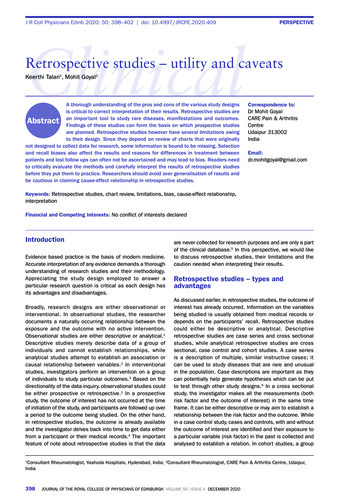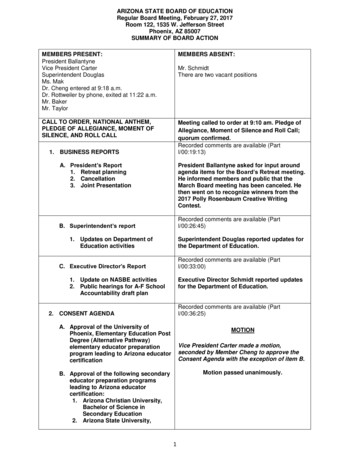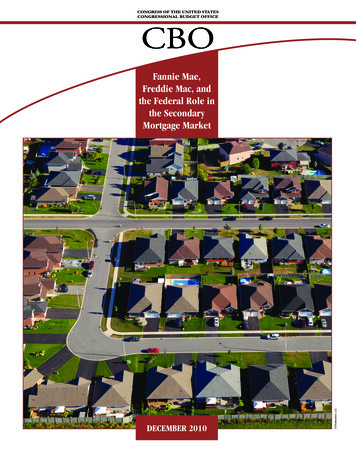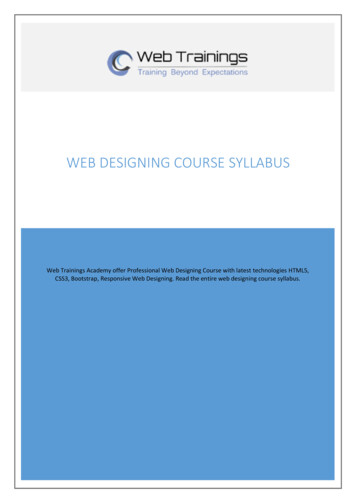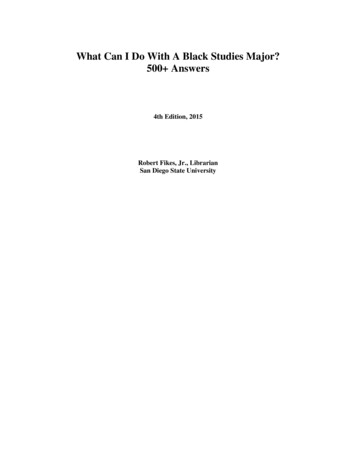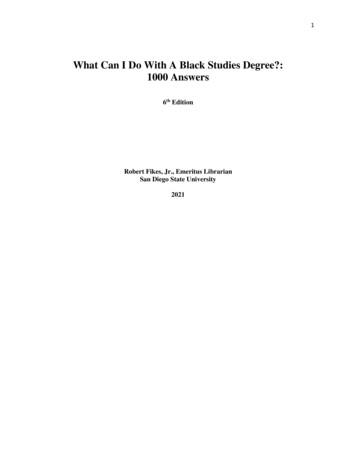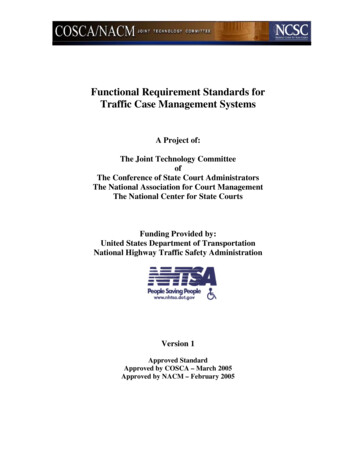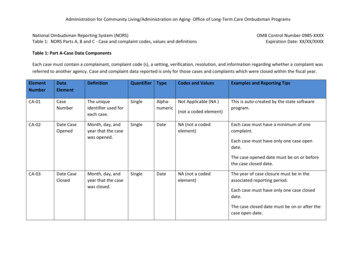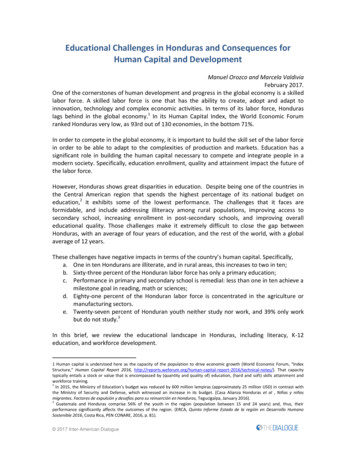
Transcription
Munich Personal RePEc ArchiveDesigning case studies from secondarysources – A conceptual frameworkReddy, K. Srinivasa and Agrawal, RajatIndian Institute of Technology (IIT) Roorkee2012Online at https://mpra.ub.uni-muenchen.de/60423/MPRA Paper No. 60423, posted 07 Dec 2014 08:46 UTC
Published Article. International Management Review, 8(2), 63-70, 2012.Designing case studies from secondary sources – A conceptual frameworkK. Srinivasa Reddy*Doctoral Student (PhD), Department of Management StudiesIndian Institute of Technology Roorkee, Roorkee - 247667Uttarakhand (India).Mobile: 919690033987; E-mail: srinuddm@iitr.ernet.in; cssrinivasareddy@gmail.comDr. Rajat AgrawalAssistant Professor, Department of Management StudiesIndian Institute of Technology Roorkee, Roorkee - 247667Uttarakhand (India).Phone: 91-1332-285-737; E-mail: rajatfdm@iitr.ernet.in*Corresponding AuthorAcknowledgementsAuthors are thankful to Editor-in-Chief and Editorial board of InternationalManagement Review (IMR) Journal for giving an opportunity to publish a case-preparatoryguidelines manuscript. Thanks are due to anonymous reviewers for helpful comments on theearlier version. Mr. Reddy personally thank his chief supervisor Prof. Vinay K. Nangia forvaluable research supervision.Citation of this article in an APA style:Reddy, K. S., & Agrawal, R. (2012). Designing case studies from secondary sources – Aconceptual framework. International Management Review, 8(2), 63-70.Click on the following link to view/download the article from Journal f1
Published Article. International Management Review, 8(2), 63-70, 2012.Designing case studies from secondary sources – A conceptual frameworkAbstractPurpose: Liberalization and globalization had risen the opportunity to third world nations forthe development of industry and educational standards. This paradigm inspires us to suggest aconceptual model for writing case studies, and encourage the faculty and instructors likely toapply the case learning method in management programs.Design/Methodology/Approach: This paper has prepared from the viewpoint of faculty andresearchers, and developed a conceptual framework for case writing.Findings: The framework for writing Type II Case Studies would be great helpful to faculty,doctoral scholars and research consultants while teaching management theories effectively ina lecture theater. Exclusively, authors suggest case structure, and a list of reputed casepublishing journals.Research limitations: The conceptual study is written from the perspective of managementstudies and the same may apply for possible results in other areas like engineering, medical,political sciences, etc. with requisite modifications.Practical implications: Faculty, senior researchers and budding scholars may apply thesuggested conceptual framework while designing case studies from secondary sources. It alsohelps them in publishing literary work.Originality/Value: This is an original attempt, to develop a conceptual framework forwriting Type II Case Studies from the availability of authenticated secondary sources.Keywords: Case study, secondary data, learning, teaching note, management education,management studiesPaper type: Conceptual paper2
Published Article. International Management Review, 8(2), 63-70, 2012.1. IntroductionManagement is an art, which design policies and guidelines; on the other hand,management is a science that deals with systematic decision-making (Burton & Thakur,1995; Koontz & Weihrich, 2010). A well repute, and valuable contributors, like F.W. Taylor,Henry Fayol, and Peter F. Drucker and other well-known scholars define the word“management” in various contexts with different approaches, and explore multiple definitions(Ivancevich, Donnelly, & Gibson, 2003). Nevertheless, decision-making is a crucial aspect inmanagement era, which affects the organization fortune. Most of the business decisions aretypical in nature and decisive, however these are in the hands of human beings. Growingimportance of management education, and rapid changes in industry with respect to products,technology, markets structures and so on, have been risen an opportunity that prone to beacademia, consultants, researchers, and industry personnel in crafting course structure andteaching pedagogy, which would be suitable for industry requirements. Alternatively,businesses are crossing boundaries of nations, and continentals to establish and create auniversal market consisting of vendors and customers.Global business transactions and changing customer preferences have givenlikelihood to teach management theories, concepts and models through real life case studies.Historically, case method was born in medical studies and research that deals with humanbeings and animals. Thereafter, the focus of case method represents in behavioral, social andpolitical sciences. Most of the contributors like Isidora, Dorde and Milovan (2010), Pamelaand Susan (2008), and Yin (2003) have suggested different frameworks for conducting a casestudy research (CSR) in diverse subjects. CSR applies exclusively to build subjectfoundation, develop theories and concepts as a token of contribution to the existing literature.In the present scenario, companies are reserving, protecting, hiding, and un-disclosing thereal facts of their business to the consultants, analysts and academic researchers. Hence, amedia (e.g., tele, print, and web) has greater potential to grasp firm information, also relevantto industry and country. Taking this is an opportunity; our conceptual framework is suggestedto design case studies form the available secondary based non-copyrighted and copyrightedinformation as well. These types of case studies are very well fitting with managementnotions and models. Therefore, we define these cases are Type II Case Studies. Contextually,case studies that have been written through face-to-face interviews are classified as Type ICases, which are more realistic and expediency compare to Type II Cases. We also definethat the case study has designed through field research is sorted as Field Cases. Field cases3
Published Article. International Management Review, 8(2), 63-70, 2012.are time consuming, and then require pragmatic research data that is more familiar insciences.To understand the inside citation (also called, in-text citation), readers may go throughthe following published cases in Emerald Emerging Markets Case studies Collection.Bick, G., Luiz, J., & Townsend, S. (2011). MTN South Africa: one group, one vision andone brand. Emerald Emerging Markets Case Studies (Marketing), Emerald Publishers.Nangia, V. K., Agarawal, R., Sharma, V., & Reddy, K. S. (2011). Conglomeratediversification through cross-continent acquisition: Vedanta weds Cairn India. EmeraldEmerging Markets Case Studies (Strategy), Emerald Publishers.Thaker, K. (2011). General Motors India (2009). Emerald Emerging Markets CaseStudies (Strategy), Emerald Publishers.The remaining study is organized as follows. Section 2 portrays the conceptualframework for designing the case studies, section 3 describes unique structure to write ateaching note, section 4 presents both pros and cons of secondary based case studies, andfinally conclusions depict in section 5.2. Conceptual framework – Designing case studies from secondary sourcesTo achieve the objective of study, this section presents a conceptual framework fordesigning case studies from secondary sources. It suggests the process in a sequence, anddescribes various tips to be taken care while preparing Type II case studies. Figure 1 portraysthe suggested notion in a flowchart.4
Published Article. International Management Review, 8(2), 63-70, 2012.Fig 1. Designing case studies from secondary sources5
Published Article. International Management Review, 8(2), 63-70, 2012.2.1 Select an area/elective:It is suggestible to pick any area of management, or others like political science,economy, industry, country news, culture, (or) it can be buzz topic/discussion of the weeknews. In few instances, interdisciplinary area topics are relevant that would act as a guide.2.2 Collection of secondary dataIt is an extreme area and main course while designing Type II cases. Authors should inquire about secondary information whether it has copyrighted orfreely accessible. If it is copyrighted, authors must quote the right citation. Further, they should also care about the quantity and quality of information that wouldbe collected (see Figure 2 for secondary sources). While collecting data, authors are suggested to write each citation in any order (e.g.,references style) and save in the separate file, for example, date wise and type of data. The final step in data collection helps the contributors to save time, which is presentedin a data sorting and classification section. It is suggestible to keep the order of databy person, organization, time, location, and activity.Sources of DataSecondary DataPrimary ataRegulatoryagenciesWeeklynewsIndustrynewsFig 2. Data collection – Secondary sources2.3 Data sorting and classificationCase contributors are required to read the collected data, and mark the important linesby any shaded color for an easy understanding, conversely, it helps in a classification. Afterselecting the crucial data, the data can be classified as introduction part, body part, crucialpart, additional information, teaching question, and case analysis. Generally, classificationdepends on the profundity, and broadness of the case.6
Published Article. International Management Review, 8(2), 63-70, 2012.2.4 Writing first draft of the caseAccording to data classification, authors must keep the select information in order, i.e.paragraph wise. Second, divide the entire text into paragraphs, multiple sentences, boxes,tables, graphs wherever it is necessary. Third, arrange the information in new file, and thenname as a case-second draft. Fourth, it is necessary to read the entire case for more than twiceor thrice to understand the case inputs. Finally, the case writer can proceed to write a casefinal draft.2.5 Beautification of the final draft of the caseBefore finalizing the case/final editing, contributors may follow the suggestions givenbelow. Give a case-second draft to any two of your colleagues, one should be good inlanguage, and other one in domain knowledge (we strongly recommend that this is animportant action for first time case writers). Read the case, as you are a reviewer, and check the proper connection between thelines and paragraphs. If the connection is lacking, then link those sentences. Check the language grammatical mistakes because the information has collected fromvarious sources, and it could possibly affect the soundness of words. Do not construct the case like a research article, commentary, or literature review.Therefore, case writers must design the case in a structured comportment (seeAppendix I). Implement the suggestions recommended by internal reviewers, if any Read the case at least twice and point yourself, modifications if any Last but not least, beautify the case – coloring lines, pictures, graphs, boxes, tablesand exhibits. However, formatting should not be overly fashioned.3. Teaching noteThe simplest way of teaching management/business case is to avoid unwanted theory,notes and over discussions. As noted, it is suggested to accommodate the case whilepreparing teaching or session plan for the next semester. Teaching note (TN) is the secondfacet of writing management case studies. In previous days, we observe that the businesscases are accompanying by case discussions and questions. Changing time and environmentalprogress and its effect on business, remark the contributors to restructure the teaching note.7
Published Article. International Management Review, 8(2), 63-70, 2012.Thus, a student could enhance practical functions while sitting in the lecture auditorium.Moreover, the following teaching note has written from the outlook of management literature.Besides, it would be a wallet to academic scholars and individual contributors in otherdisciplines.TN must be well referred and written from the instructor’s point of view. A goodteaching note must inspire the faculty, and motivates him to deliver key points in the givencase through diverse management theories and concepts. If the case belongs to finance,accounting, or any other technical subject, then the teaching note must provide casediscussion, case analysis, and exercises with answers. As a result, faculty can deliver the casein good time with poise as well as answer the student queries. Figure 3 presents the outlinethat how to write an advanced teaching note. Subsequently, important elements have beendiscussed for an auxiliary inquiry.Fig 3. Conceptual framework – Teaching noteAs discussed above, it is proposed to use a triangular support while writing teachingnote for case studies. TN is generally a mechanism for mock discussion, which is written onthe paper. On the other hand, it is training capsule to the faculty and case instructors. Thefollowing steps are part of the TN.8
Published Article. International Management Review, 8(2), 63-70, 2012.3.1 Case overviewUsually, this section should be prime step in TN. It covers case subject area, relevanceof data, facts and crucial aspects. It does not cover any additional information other than thecase disclosure. Simply, it is case a description/case synopsis.3.2 Case learning objectivesEach case should be accompanied by learning objectives. Because, these objectivesmotivate the faculty, and then comes to know that what would be the learning from the givencase. It is also suggested that these points must be present in bullets format.3.3 Case illustrations, discussions and assignmentsA good case must pinpoint the faculty and students via giving assignments. Normally,it depends on the subject area of case, for example, finance, accounting and operations –assignments would be in workout/exercises. On the other hand, Marketing and HR –assignments would be in theoretical questions and conceptual discussions (for example,brainstorming, presentations, etc).3.4 Case analysisThis section helps the faculty/instructors while discussing the given case in the lecturetheater. Therefore, Case writers are required to analyze the case from the viewpoint ofinstructors, i.e. if you are a fresh academic instructor, how do you discuss the case amongstudents in the lecture hall?For example, First 15-20 minutes teaching plan (see, additional readings) Mechanism of case analysis and discussion of questions with in a time frame Question yourself and answer them Tabulation, graphs, using blackboard, and other teaching materials3.5 Case feedbackAfter the case assignment and discussion, faculty is suggested to take feedback on thegiven case. The feedback report helps him while selecting cases, teaching pedagogy or anyother improvements for prospect growth. On the other hand, faculty comes to know that whatdifficulties, which students have faced during case analysis. The feedback report improvescommuniqué and interaction between the faculty and students in the lecture hall. It can be9
Published Article. International Management Review, 8(2), 63-70, 2012.oral or written, and may collect through online submission/email. Box 1 presents thesuggestive feedback mechanism for case studies discussion. Students normally give theirfeedback on case learning using five point Likert’s scale. This feedback assists the facultymember for progress in teaching pedagogy that would lead to their career advancement.Box 1. Case feedback formFactor1Case title/synopsis2Relevancy of the subject3Case learning4Case inputs to students5Area/elective I6Area/elective II7Area/elective III8Overall opinion on the case9Practicality and decision10Teaching methodLikert’s scaleVery poorPoorAverageGoodExcellent4. Pros and Cons of Type II Case StudiesThe present conceptual study has both merits and limitations like theoretical studies inmanagement and other sciences. The following observations have been made as critiquesabout the Type II case studies (see Box 2).Box 2. Pros and Cons of Type II Case StudiesProsCoding and timing of the case collection data.Case release form, i.e. permission is not required fromany person, firm or entity to publish Type II teachingcases. Because of case release form, many young casewriters get disappointed, even not interested to writecases for publication. In this setting, Type II cases aremore suggestible and appropriate for publication.Easy to write and edit the raw data.Learning objectives are clear and indicative.Opportunity to present at seminars and conferences,and publish in case journals (see Appendix II).Limited availabilityinformation.Consof authenticatedsecondaryIn some instances, it is difficult to sort and classify theraw data.Getting relevant data is a difficult task.Data lost and alteration is a tragedy.Writing Type II case studies require more time.Linguistic mistakes, editing and clarification.5. Concluding remarksA good case study supposes to fulfill the learning objectives and feed the practicalapplications, or managerial decisions through theories, concepts, models and principles.10
Published Article. International Management Review, 8(2), 63-70, 2012.Further, the case should be flexible to teach or insert a theme in different areas of study. Acase encloses multiple faces would guide faculty and students in effective manner. Teachingtheory through case learning is an interesting task, and it gives a meek confidence andopportunity to insight the issues more in depth rather than broad coverage. The changingbusiness scenario and environment is a remarkable, and requires both soft and hard pedagogyto achieve objectives by the student peer groups. This conceptual framework suggest thathow to design case studies from the secondary sources, which may facilitate faculty,instructors, senior researchers, authors and young scholars in their publications. Additionally,they shall not require waiting for case permissions to write Type II case studies. We believethat the study would inspire budding researchers and fresh faculty while applying caselearning method in a lecture theater.ReferencesBurton, G., & Thakur, M. (1995). Management Today – Principles and Practice. New Delhi:Tata McGraw-Hill.Isidora, D., Dorde, N., & Milovan, V. (2010). The role of case study method in managementresearch. Serbian Journal of Management, 5(1), 175-185.Ivancevich, J. M., Donnelly Jr. J. H., & Gibson, J. (2003). Management – Principles andFunctions. 4th Ed. Richard D. Irwin Inc., USA.Koontz, H., & Weihrich, H. (2010). Essentials of Management – An InternationalPerspective. 8th Ed. New Delhi: Tata McGraw Hill.Pamela, B., & Susan, J. (2008). Qualitative case study methodology: study design andimplementation for novice researchers. The Qualitative Report, 13(4), 544-559.Yin, R. K. (2003). Case Study Research – Design and Methods. 3rd Ed. Thousand Oaks, CA:Sage Publications.Additional ReadingsDhankhar, M. S. (2010). Five suggestions to improve quality in education. University News –A Weekly Journal of Higher Education, 47(52), 13-14.Emerald Publishers. How to write a teaching note. Available at: -To-Write-A-Teaching-Note.pdf (accessed December 10,2011).European Case Clearing House. ECCH the case for learning. Available at: www.ecch.com11
Published Article. International Management Review, 8(2), 63-70, 2012.Farhoomand, A. Writing teaching cases: a quick reference guide. Available quick ref.pdf (accessed November30, 2011).Ivey Publishing. Ivey – Teaching & Authoring tools. Available at: aspxKachru, U. (2008). Strategic Management – Concepts and Cases. New Delhi: Excel Books.Singh, R. P. (2008). Quality assurance in educational research: A quest for possibility.University News – A Weekly Journal of Higher Education, 46(48), 10-17.Sreekala, E. (2010). Blended learning as a strategy of innovation in education. UniversityNews – A Weekly Journal of Higher Education, 47(49), 16-18.APPENDIX12
Published Article. International Management Review, 8(2), 63-70, 2012.Appendix II. List of Case Publishing Journals in Business and Management studiesJournal/CollectionPublisher/InstituteWeb address1Asian Case Research JournalWorld Scientificwww.worldscinet.com/acrj/2Asian Journal of Management CasesSage Publicationshttp://ajc.sagepub.com/3Business Case JournalSociety for Case Researchwww.sfcr.org/bcj/4Emerging Markets Case StudiesEmerald Publisherswww.emeraldinsight.com5European Case Clearing HouseECCHwww.ecch.com6IIMS Journal of Management ScienceIIM Shillong, UM Journal of Case Studies in ManagementGraduate School of Management,International Islamic University tle home8IMA Educational Case JournalInstitute of Management Accountancyhttp://www.imanet.org/resources and publications/ima educational case journal.aspx9International Journal of Case Studies in ManagementHEC – 0International Journal of Management CasesCIRCLE Research Centrehttp://www.ijmc.org/IJMC/Home.html11Ivey CasesIvey Collectionswww.iveycases.com12Journal of Business Case StudiesThe Clute 13Journal of Case Research in Business and EconomicsAABRIwww.aabri.com/jcrbe.html14Journal of the International Academy for Case StudiesAllied Academieshttp://www.alliedacademies.org15The Management Case Study Journal16VikalpaInternational Graduate School ofManagement, University of South AustraliaIIM Ahmedabad, tails.aspx?id MCSJ&container businesshttp://www.vikalpa.com/17VisionMDI Gurgaon, Indiahttp://www.mdi.ac.in/intellect capital/vision.asp?id 3Note: We have not been suggested any local case publisher either in India or elsewhere. However, the above list may help case authors in finding a suitable outlet for their case.13
2. Conceptual framework - Designing case studies from secondary sources To achieve the objective of study, this section presents a conceptual framework for designing case studies from secondary sources. It suggests the process in a sequence, and describes various tips to be taken care while preparing Type II case studies. Figure 1 portrays


